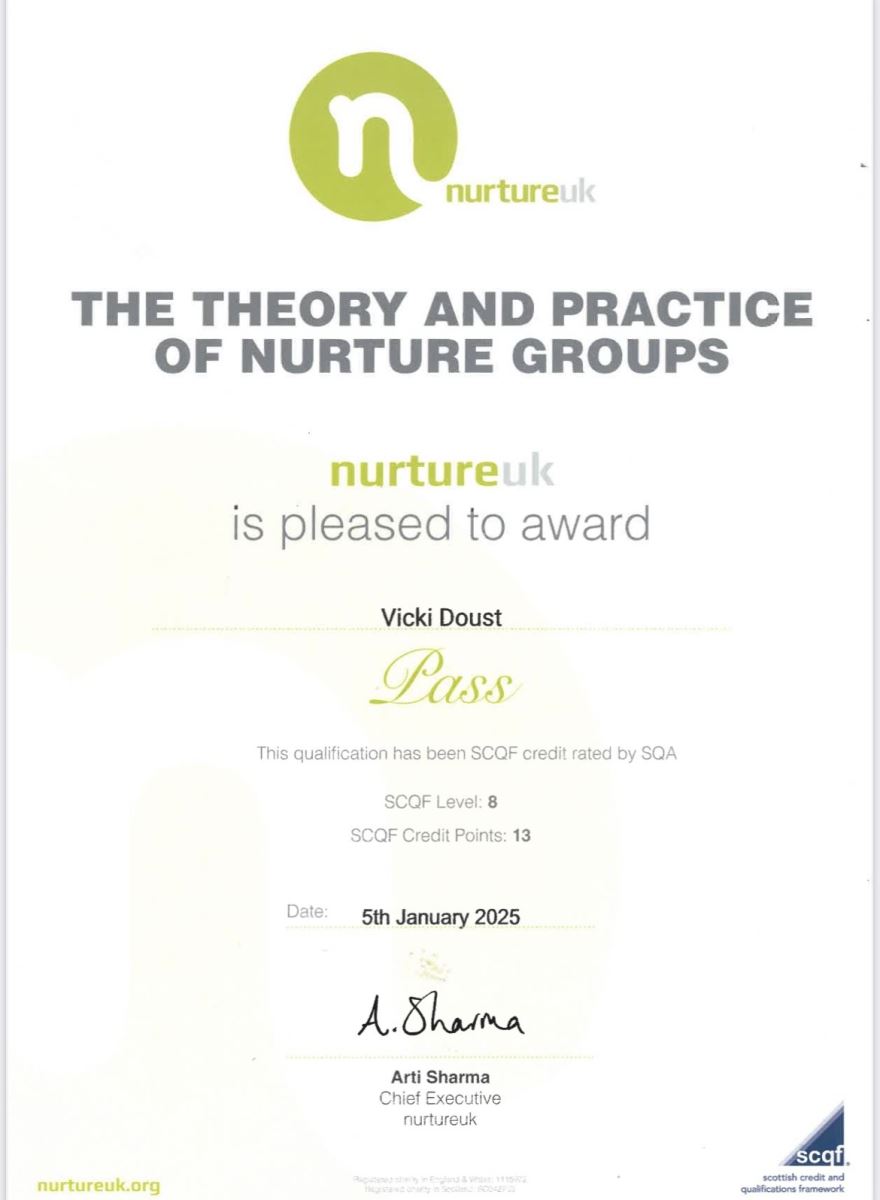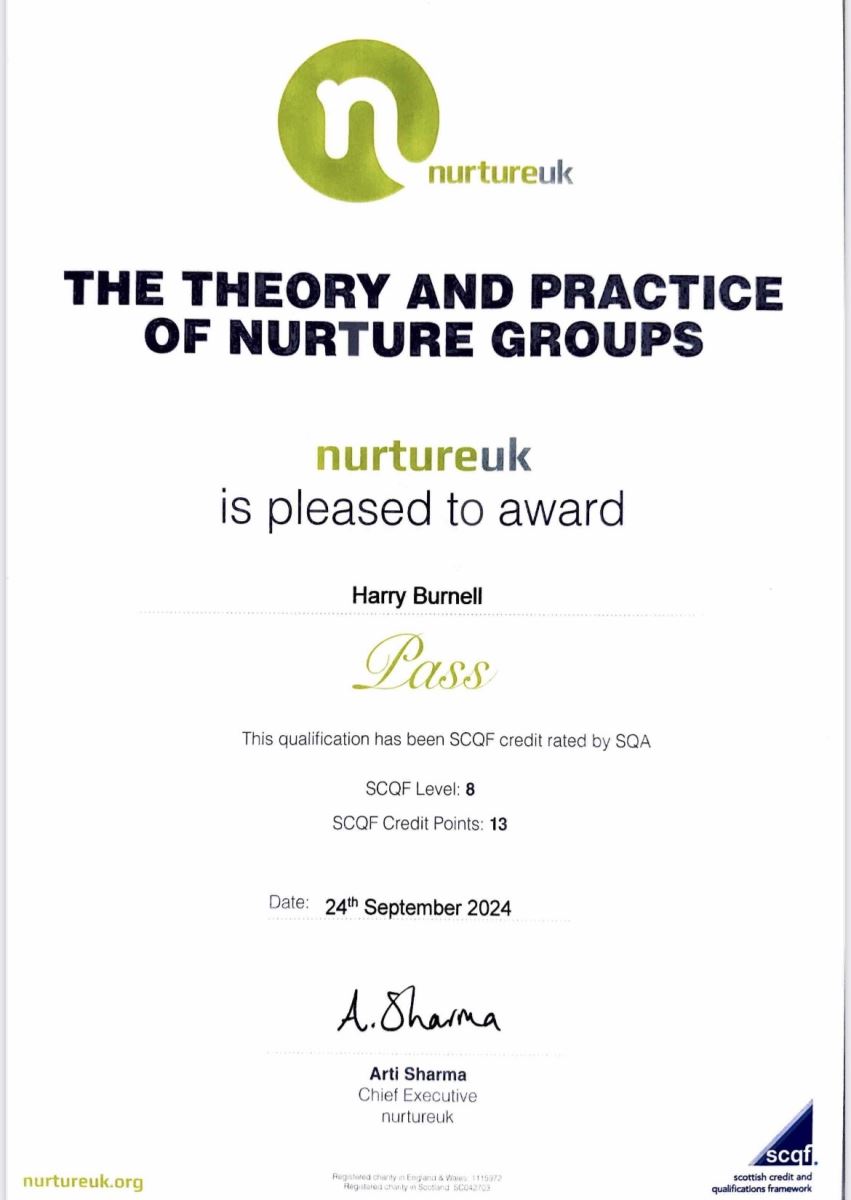 Rights Links: Article 3 – Best Interests of the Child; Article 12 - Respect for the Views of the child; Article 24 – Health and Health Services; Article 29 – Goals of Education
Rights Links: Article 3 – Best Interests of the Child; Article 12 - Respect for the Views of the child; Article 24 – Health and Health Services; Article 29 – Goals of Education

What Is Nurture?
The concept of nurture highlights the importance of social environments and its significant influence on behaviour and cognitive ability. Children and young people who have a good start in life have a whole host of advantages over those who don’t have such positive experiences when they are little. They tend to do better at school, attend regularly, enjoy activities with friends and are significantly less likely to offend or experience problems with poor physical or mental health. Nurture groups offer an opportunity to learn the early nurturing experiences some children and young people lack, giving them the skills to do well at school, make friends and deal more confidently and calmly with the trials and tribulations of life, for life.
What is a Nurture Group?
Nurture groups are founded on evidence-based practices and offer a short-term, inclusive, focused intervention that works in the long term. Nurture groups are classes of between six and 12 children or young people in early years, primary or secondary settings supported by the whole staff group and parents. Each group is run by two members of staff. Children attend nurture groups but remain an active part of their main class group, spend appropriate times within the nurture group according to their need and typically return full time to their own class within two to four terms. Nurture groups assess learning and social and emotional needs and give whatever help is needed to remove the barriers to learning. There is great emphasis on language development and communication. Nothing is taken for granted and everything is explained, supported by role modelling, demonstration and the use of gesture as appropriate. The relationship between the two staff, always nurturing and supportive, provides a role model that children observe and begin to copy. Food is shared at ‘snack time’ with much opportunity for social learning, helping children to attend to the needs of others, with time to listen and be listened to. As the children learn academically and socially they develop confidence, become responsive to others, learn self-respect and take pride in behaving well and in achieving. Nurture groups have been working successfully for more than 40 years in the UK and now in other countries including Canada, New Zealand and Romania, and have been praised, supported and recommended by organisations such as Ofsted, Estyn and HMIE.
The Six Principles Of Nurture
1. Children's learning is understood developmentally
2. The classroom offers a safe base
3. The importance of nurture for the development of wellbeing
4. Language is a vital means of communication
5. All behaviour is communication
6. The importance of transition in children's lives
Ref: Lucas,S., Insley,K. and Buckland,G. (2006) Nurture Group Principles and Curriculum Guidelines Helping Children to Achieve, The Nurture Group Network.
The Marjorie Boxall Quality Mark Award
To recognise the work of nurture groups that have been running for two years or longer, the Nurture Group Network runs an accreditation scheme for excellence in nurturing: The Marjorie Boxall Quality Mark Award.
The QMA is a real honour for the schools that own it, reflective not only of the hard work of the students but the dedication of the staff, and provides a hard evidential base for the oft-quoted statement that nurture works. Since the inception of the Quality Mark Award in 2007, more than 100 establishments have successfully achieved the award. The process of achieving the QMA ensures that there is an evidential base of good practice set against national standards, which is useful for planning, reviewing and reflecting on effective practices and the impact and outcomes.
At Sydenham, we are delighted to have received the Marjorie Boxall Quality Mark Award in recognition of the excellent practice which is embedded into our whole school approach. Please click on the PDF below to see a copy of our assessment feedback.
QMA-SYDENHAM-PRIMARY-SCHOOL.pdf
The Boxall Profile
What is the Boxall Profile and how effective is it?
Marion Bennathan introduces the Boxall Profile in a very clear step-by-step manner, explaining its origins and also how it can support professionals in schools today.
The Boxall Profile provides a framework for the precise assessment of children who have social, emotional and behavioural difficulties (SEBD) and are failing at school. It helps teachers to plan focused intervention for those children whose behaviour seems to make no sense. The profile provides the teacher with insights and suggests points of entry into the child's world — it makes people think about what lies behind the behaviour.
The Boxall Profile is, from a practical point of view, very easy to use. The two-part check list, which is completed by staff who know the child best in a classroom situation, is quick — and, very importantly, it is constructive.
Why is the Boxall Profile so Relevant Today?
It is widely agreed that children with social, emotional and behavioural difficulties (SEBD) are the biggest challenge to the effective running of schools. These are children who do not respond to teachers' best efforts and they can fail to learn. They can also spoil the atmosphere for the rest of the class, consuming the teacher's time and energy, diverting it away from children who could use it so much better. While a well delivered curriculum, and a behaviour policy owned by all concerned are all central to running an effective school, this is not enough to meet the needs of children with SEBD. So, what is it about the Boxall Profile that has helped literally thousands of teachers and teaching assistants to succeed, sometimes quite dramatically, in changing the response of troubled and / or troublesome children?
Where did the Boxall Profile Come From?
The profile developed as part of the nurture group movement. Nurture groups were started in Hackney, inner London, in 1969, as the response of Marjorie Boxall, an educational psychologist, to the high levels of distress in primary schools at a time of great social upheaval and teacher shortage. Referrals to special schools for children seen as having SEBD had reached unmanageable levels. Boxall brought into school a different way of looking at the behaviour that was getting in the way of the child's progress. She focused on children's early development, on their self-concept, on the attitudes they had absorbed and brought with them into school. She understood the difficulties presented by most of these children as the outcome of impoverished early nurturing. They were not able to make trusting relationships with adults or to respond appropriately to other children. They were unready to meet the social and intellectual demands of school life, and so failed.
This way of thinking made sense to teachers, who knew of the stresses in the lives of many local families. They were also well aware of pressures brought about by 'child-centred' education, which took for granted the child's ability to organise themselves, to sit round tables, cooperating with each other, with much less structure and supervision than in the old-style classrooms. Nurture groups quickly became established in many schools in inner London, and staff saw great progress in children who had been on the verge of exclusion. They also saw a great improvement in staff morale as teachers and assistants realised that they could develop the skills to improve children's lives quite fundamentally.
At Sydenham, we have three members of staff who are trained by The Nurture Network. They understand the developmental processes of childhood, that some children get stuck at an early stage and need experiences appropriate to that stage to enable them to move on. They realise that the child's first need is to build up trust. This is achieved by demonstrating acceptance of the child as s/he is, and, as confidence grows, offering work appropriate to the stage they have reached. There are secure routines, always explained — no prior knowledge is taken for granted. The child is always listened to, with staff doing what every attentive parent does, commenting on what the child tells them, expanding it, putting it in a wider context — in short, helping the child to make sense of their world. The National Curriculum is taught, but in a way which fits in with the child's developmental needs.
Boxall took a central and active part in sharing her knowledge of child development with staff working in nurture groups and trained them to look at maladaptive behaviour as an expression of underlying distress. She also freely acknowledged that, though the original concept was hers, it was teachers and assistants running the groups who 'picked it up and ran with it'. As their experience grew, staff began to want a way of looking more precisely at the hindrances to learning they saw in their pupils. They also wanted to be able to measure change and progress. This was the start of the Boxall Profile.
Some schools do not have nurture groups — they may lack the resources, or may even not have many children who cannot be adequately helped in the normal classroom. But the experience of nurture groups over the past generation has brought about a much greater understanding of the emotional content of learning. This is now being widely recognised as 'emotional literacy' and seen as relevant to all children. As the head teacher of one of the first junior schools to set up a nurture group wrote of the profile, ‘We gained a sort of positive language. To identify where a child is in different areas in its development was quite tough — there was no history or training or background to doing that. It helped people to look more perceptively, to think where does this behaviour come from? It put some structure into teachers' thinking and reporting.' Many children in school are insecure about their worth, often not able to articulate their feelings. Some may act out their feelings of anger and failure by minor or major acts of disrupting the progress of others. Whatever the behaviour, the result is that they do not get positively engaged in education. Understanding what lies behind this can make all teachers much more confident in their class management, which is where the Boxall Profile comes in.
Our trained Nurture Practitioners are: Ms Vicki Doust, Ms Lisa Catalano-Beattie and Mr Harry Burnell.


